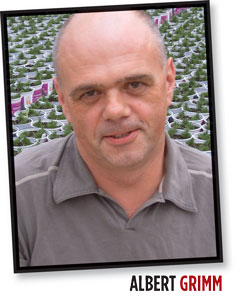1/29/2016
Finding Needs That Need Filling
Albert Grimm

What a difference 35 years make.
Since I began to work as a grower, our occupation has morphed into a presentable, and even respected, career. What used to be little more than “occupational accidents” has grown up to become a veritable profession. Job prospects are good, and knowledge and experience are well-respected assets. Greenhouse growers carry their title with pride and many graduating college students enter the industry with explicit aspirations to work as a head grower.
But what does it mean to be a grower or head grower? How does one go about qualifying for such a job? No diploma, degree or certificate offers this entitlement. In fact, during all those years that I’ve been working as a grower, nobody has ever even wanted to see my diploma, and this caused me some frustration because I have a considerable collection of honors and certificates. The real world showed no interest in my display of scholarly exploits. Greenhouse operators merely wanted to see whether I could apply my knowledge in a profitable manner.
For a grower, qualification is measured by track record, not by graduation marks. But at the outset, we have no idea how to go about building such a record. How do we know where to start? Career training is definitely not among the priorities in most greenhouse operations. Job descriptions are relatively recent introductions to commercial greenhouses. I don't recall ever receiving one. To the contrary, it was generally expected that I should be able to walk into any greenhouse and make things happen without needing to be told. When I was hired for my first real job as a section grower, the instructions from my employer on my first day of work amounted to a question as to whether I was capable of finding myself something sensible to do.
For freshly graduated horticulturists, it may very well be the one of the biggest challenges to learn how to define their own job. Diplomas and degrees are important because they open front doors to the building, but only a tangible track record gets you anywhere past the lobby and into the career elevator. Building a career in horticulture is synonymous with creating a track record and creating such a track record is synonymous with having to learn how to make those things happen that other people either don’t see or aren’t inclined to do.
One useful approach is rather simple: it’s called “find a need and fill it.” Every company has productivity gaps that nobody pays attention to. Every greenhouse has unrealized potential—be it for improved output, for better quality or for cost reduction. These are untapped opportunities, and if we can find them and if we apply ourselves conscientiously, we can eventually fill these workplace vacuums and make a real difference for our employers and for our careers.
In principle this may sound simple, but in practice it’s still difficult. We have to learn how to spot such opportunities and then we need to gather experience and skill before we’re able to fill them. It requires mentors willing to teach and companies willing to offer the room to grow. Above all, it requires patience; open minds willing to experience and learn. It also requires stamina to resist the lure of putative “real jobs,” which appear to offer easy money without all the trouble.
If you’re about to build a career as a grower, I would advise you to look for a workplace that offers opportunities to define yourself. Look for a company that takes the time to teach you how to find a worthwhile challenge. Seek employers who coach you to explore needs that aren’t filled. Look for organizations that make enough room so that you can apply yourself to finding tasks that have not yet become obvious. Look for greenhouses that allow you to explore your capabilities, to make mistakes, to face down challenges and to live up to your aspirations. Start creating your own track record.
GT
Albert Grimm is head grower for Jeffery’s Greenhouses in St. Catharines, Ontario, Canada.